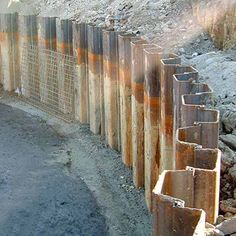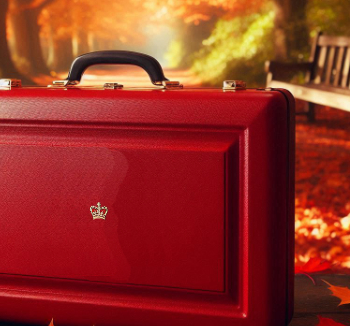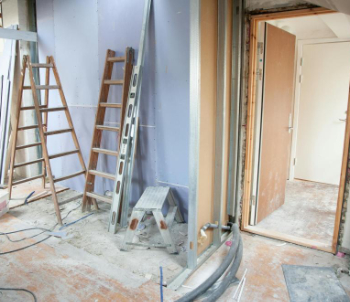Sheet piles
Contents |
[edit] Introduction
Sheet piles are sections of sheet materials with interlocking edges that are driven into the ground to provide earth retention and excavation support. Sheet piles are most commonly made of steel, but can also be formed of timber or reinforced concrete.
Sheet piles are commonly used for retaining walls, land reclamation, underground structures such as car parks and basements, in marine locations for riverbank protection, seawalls, cofferdams, and so on.
The selection of sheet piling is dependent on factors, such as:
- The type of work, for example. whether it is permanent or temporary.
- Site conditions.
- The required depth of piles.
- The bending moments involved.
- The nature of the structure.
- The type of protection required.
[edit] Timber sheet piles
Timber sheet piles are generally used for short spans in temporary structures, and to resist light lateral loads. They are typically connected together by tongue and groove joints. The disadvantage of timber piles is that they require preservative treatment and are not generally suitable for soils consisting of stones.
[edit] Reinforced concrete sheet piles
Reinforced concrete sheet piles are formed using precast concrete members, usually connected together by tongue and groove joints. They are commonly used in permanent river embankments, canals and other marine structures. The toes of the piles are usually cut with an oblique face to facilitate easy driving and interlocking, while the heads are finished off by casting a capping beam.
[edit] Steel sheet piles
Steel is the most common form of sheet piles as it has good resistance to high driving stresses, excellent water-tightness, and can be increased in length either by welding or bolting. They are connected by interlocking.
There are four basic forms of steel sheet piles:
[edit] Normal sections
These include Larssen and Frodingham sheet piles, which are systems of interlocking steel piles. They have good driving qualities and are designed to provide good strength for low weight.
The interlocking system facilitates easy positioning of the piles (pitching) and driving, as well as providing a close-fitting joint to form an effective water seal. In some cases, a sealant can be brushed into the joints prior to pitching which expands in thickness to form a watertight joint.
Larssen sheet piles are stronger and easier to drive because of their uniform section shape. Frodingham sheet piles are usually supplied interlocked in pairs, which makes them easier and quicker to handle and pitch.
[edit] Straight web sections
These are piles that are interlocked and driven to form cellular cofferdams which may be filled with material such as gravel and small rocks.
[edit] Box sections
These are formed by two or more sheet pile sections welded together and are suitable when heavy loads and high bending moments are anticipated.
[edit] Composite sections
These are commonly used in waterfront protection where large bending moments and heavy axial loads are anticipated. A typical composite pile is a double Frodingham section welded to the flange of a universal I-beam.
[edit] Installation
Prior to installation, piles should be carefully inspected for straightness, cracks, and the integrity of the interlocking components.
Driving must be carefully monitored and should stop immediately if the pile ceases to penetrate the soil, before moving on to the next pile along. In some cases, several adjacent piles will be unable to penetrate to the design depth. At this point, effort should be made to remove the obstacle, either by partial excavation or using a water jet. There is an acceptable number of ‘under-driven’ sheet piles, but this will vary according to the specific design requirements.
Sheet piles have a tendency to deviate from a vertical plane during driving and instead lean sideways. This is due to encountering obstacles within the soil which act as deflection. Guide controls should be used to counter this.
One technique is to drive piles in panels. This involves pitching and driving two piles to part or full-penetration at either end of a panel of piles. The panel is therefore supported by the ‘bookended’ piles during driving to their final position. The pair left on the end then forms the support of the next panel along.
Another technique is to use trestles and walings to support and position sheet piles during driving.
Vibratory hammers are often used to install sheet piles, although if soils are too hard or dense, an impact hammer can be used. At certain sites where vibrations are a concern, the sheets can be hydraulically pushed into the ground.
[edit] Related articles on Designing Buildings
- All you need to know about sheet piling.
- Bored piles.
- Capping beam.
- Cofferdam.
- Continuous flight auger piles.
- Diaphragm wall.
- Driven piles.
- Groundwater control in urban areas.
- Groundworks.
- Micropiles.
- Pile cap.
- Pile foundations.
- Pile wall.
- Retaining walls.
- Screw pile foundations.
- Secant pile wall.
- Temporary works.
- Z piles.
- Types of pile foundation.
Featured articles and news
Considerate Constructors Scheme acquires Building A Safer Future
Acquisition defines a new era for safety in construction.
AT Awards evening 2024; the winners and finalists
Recognising professionals with outstanding achievements.
Reactions to the Autumn Budget announcement
And key elements of the quoted budget to rebuild Britain.
Chancellor of the Exchequer delivers Budget
Repairing, fixing, rebuilding, protecting and strengthening.
Expectation management in building design
Interest, management, occupant satisfaction and the performance gap.
Connecting conservation research and practice with IHBC
State of the art heritage research & practice and guidance.
Innovative Silica Safety Toolkit
Receives funding boost in memory of construction visionary.
Gentle density and the current context of planning changes
How should designers deliver it now as it appears in NPPF.
Sustainable Futures. Redefining Retrofit for Net Zero Living
More speakers confirmed for BSRIA Briefing 2024.
Making the most of urban land: Brownfield Passports
Policy paper in brief with industry responses welcomed.
The boundaries and networks of the Magonsæte.
London Build Fire and Security Expo
20-21 Nov and now with new Ambassador Programme..
The Scottish Building Safety Levy
Eight weeks of consultation closing on 18 November.
The grey, the brown and the golden rules of housing
shifting policies from the wild west of housing development.
Future proofing homes that are fit for purpose
Specification challenges and the role of plastic.
Thousands of new homes unlocked for brownfield sites
£68 million to 54 councils for neglected land into new homes.


























Comments